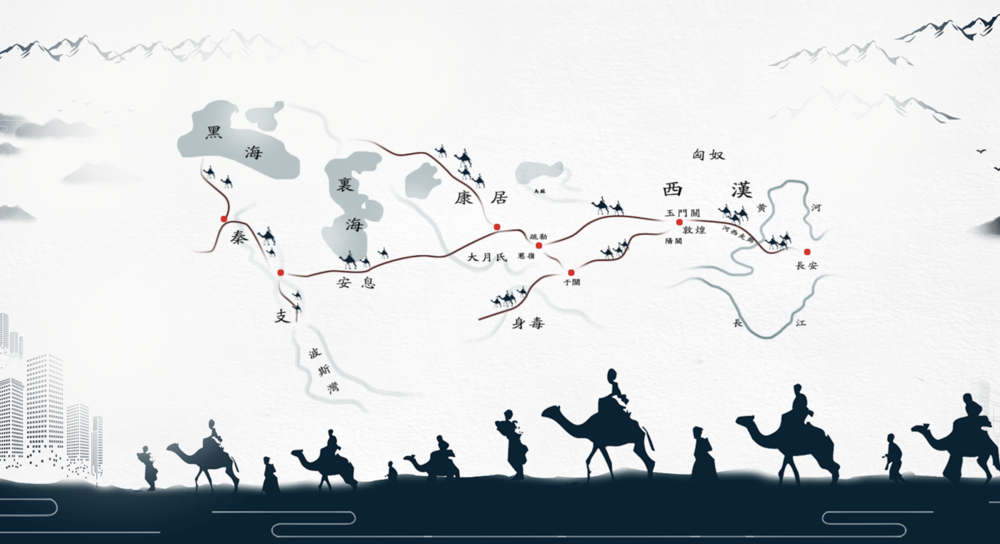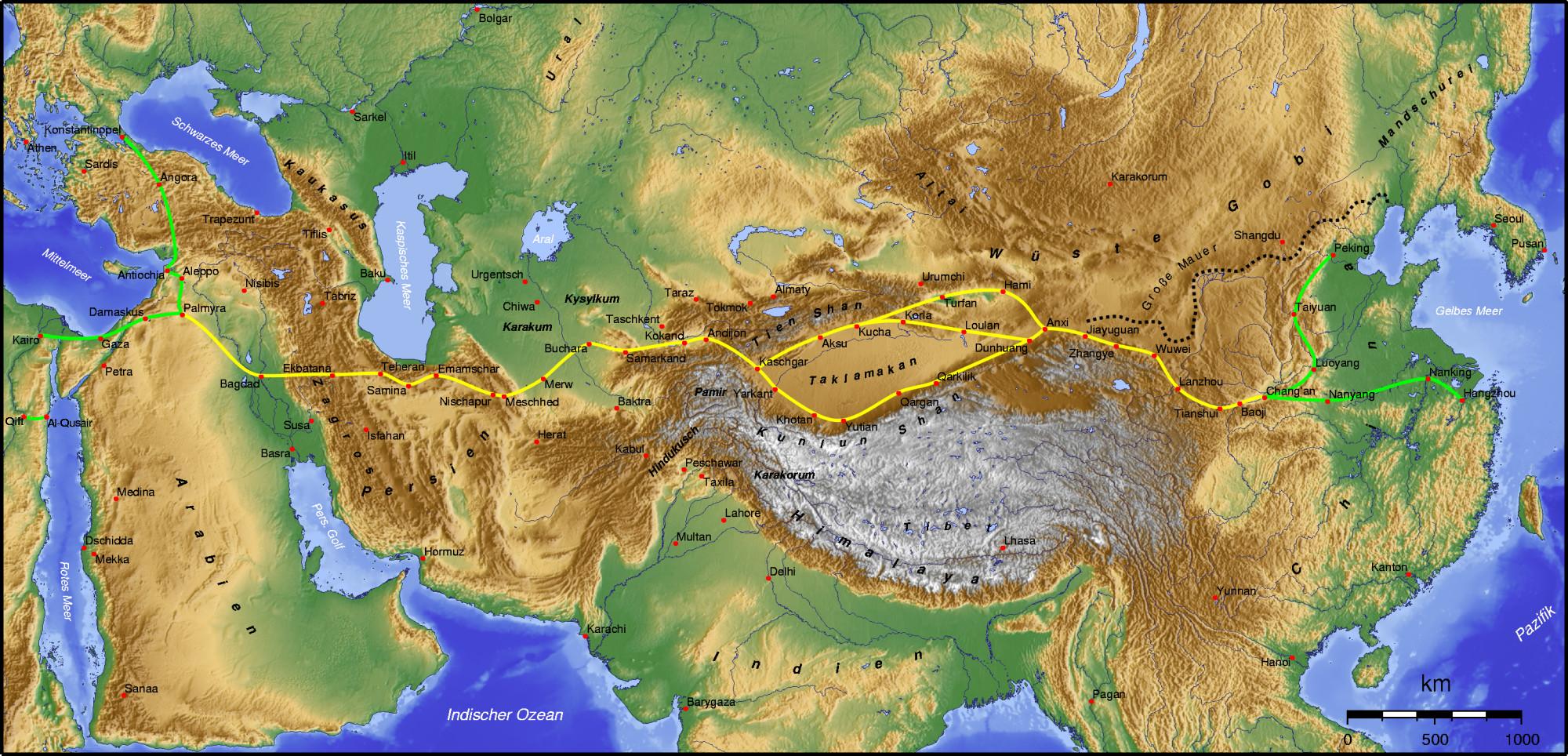Millenium China Silk Road

Block Title
The Silk Road was a network of trade routes connected the East and West.
The Silk Road primarily refers to the land routes connecting East Asia and Southeast Asia with South Asia, Persia, the Arabian Peninsula, East Africa and Southern Europe.
The Silk Road gets its name from the business trade in silk carried out along its length, beginning in the Han dynasty in China (207 BCE–220 CE). The Chinese took great interest in the security of the trade and extended the Great Wall of China to ensure the protection of the trade route.
The Silk Road trade played an important role in the development of the civilizations. It opened long-distance political and economic relations between Asia and Europe. Not only silk was exported from China, but also many other goods and ideas were exchanged, including, philosophies, sciences and technologies. Diseases also spread along the Silk Road.
Marco Polo followed this route, reached China overland via Khotan. He began his homeward journey by a ship on the Maritime Silk Road from Quanzhou to Iran.
In June 2014, UNESCO designated the Chang’an-Tianshan corridor of the Silk Road as a World Heritage Site.
Block Title
Highlights of the tour of China Silk Road :
Terracotta Warriors – UNESCO World Heritage Site
Xi An is the start of your China silk road tour. The Terracotta Warriors and Horses is 40 km away from Xi An city. It is one of the greatest man-made wonders in the world. It is built by the first emperor of China, Qin Shihuang to protect him in his afterlife. There are over 8,000 life-size warriors, horses and chariots, buried in 3 pits for more than 2,000 years. It is discovered by a local farmer in 1974. It is an ancient military army with complete battle units of infantry and cavalry. Standing in front of these figures, one can not help being amazed not only by the ambition of Emperor Qin Shihuang but also by the fabulous artistic skills of ancient Chinese artisans. During the visit, you will have an opportunity to make a miniature Terracotta Warrior by your own under the instruction of a local potter.
City Wall of Xi’an (西安城墙; Xīānchéngqiáng)– UNESCO World Heritage Site
To take a wonderful stroll on the Ancient City Wall, you will see the largest and best-preserved ancient city wall in China. People can enjoy panoramic views of the modern city of Xi An. This well-maintained city wall is 12 meters high and 18 meters wide with a total circuit of 14 kilometers. The tourists can rent bikes, it’s ¥45 per 2 hours plus a refundable deposit. The present city wall was built in the Ming dynasty(A.D.1368-A.D.1644) on the foundation of the Chang’an Imperial city wall of Tang dynasty(A.D.618-A.D.907). The Xi’an City Wall International Marathon is held each year in Nov. since 1993, running on top of the wall.
Giant Wild Goose Pagoda – UNESCO World Heritage Site
Giant Wild Goose Pagoda (大雁塔; Dàyàntǎ) was built by Emperor Gaozong Li Zhi(高宗李治) in 652AD. It is the landmark of the city of Xi’an. In the fountain in front of the pagoda, there is a very nice water and music show at various times during the day. There needs a ticket with payment 90 RMB to enter the park and the pagoda.
The Magic Crescent Lake nearby Dunhuang
On the way to Dunhuang, the crescent lake is located in a same scenic area. Crescent Lake has been a famous attraction for more than 1200 years. In the sunny days, the sand mountains echo like Orchestra music even if there is no wind. If you slide from the sand mountains, you can hear the echoing sound clearly. There are many exciting activities for you to try, such as sand skiing, viewing from glider or helicopter, motorcycling, etc. Riding a camel through the desert is very popular. Surrounded by the Echoing Sand Mountains, Crescent Lake is a beautiful oasis with some well decorated traditional Chinese architecture, some trees and flowers and a lake that has never dried up and shapes like a crescent moon. If you like, you can camp for a night in the desert of Mingshashan. It is a kind of experience to get closer touch with the desert. During the camping, there are a lot of activities and funs, sand skiing, desert motorcycle, bonfire party, etc.
Mogao Grottoes in Dunhuang
Mogao Grottoes is famed as the “Louvre of the East”. It is outstanding for its exquisite mural paintings and statues. There are 492 grottoes, about 45000 square meters mural paintings and 2100 colorfully painted statues. You can trace the development of Chinese art over 1600 years from one dynasty to the next. Because each dynasty built its own caves to record its own features. There are about 40 common caves opened to the public. In the tourist area, you will be divided into groups by different tour guides who will accompany you to visit the caves with great introduction. After that, if you want to visit more other caves, you can do it by yourselves or follow other tour guides. Besides, there are 10 special caves with extra fees.
Landscape of Danxia National Geopark in Zhangye
The Zhangye National Geopark (张掖国家地质公园pinyin: Zhāngyè Guójiā Dìzhìgōngyuán) is located in Zhangye, Gansu province of China. It covers an area of 124 sq miles. It was formally designated as “Zhangye National Geopark” in 2016. Zhangye Danxia is known for the unusual colors of the rocks, smooth, sharp and several hundred meters tall. They are the result of deposits of sandstone and other minerals occurred over 24 million years. In 2009, Chinese National Geography magazine chose Zhangye Danxia as one of the “six most beautiful landforms” in China. A series of boardwalks and access roads have been built to help visitors to explore the rock formations.
Flaming Mountains and Grape Valley in Turpan
When we explore the fire land, Turpan is famous for the fire land, flaming mountains, watermelons and vineyards. The first attraction is the brilliant project – Karez System, a special kind of irrigation system consisting of vertical wells, underground canals, ground canals and waterlogging pond. The vertically dug wells are linked together to channel the water. The water comes from the melting snow from TianShan mountains during summer rain season. The tourists can also enjoy the pleasant cool of the Grape Valley, where you can also taste some delicious grapes and other fruits.
Urumqi City Tour
There is 3 hours driving from Turpan to Urumqi. It is the capital city of Xinjiang Uyghur Autonomous Region. Urumqi is also known as East Turkestan , located in the Tian Shan mountains. The urban population is around 2.5 million. There are three major ethnic groups, majority Han, Hui muslin people, and Uyghur (a Turkic ethnic group).
Heaven Mountain and Heaven Lake Tour
The beautiful Heaven lake is located on the Heaven Mountain. In a fairytale, tt was the fairyland where the Heavenly Queen lived. The summer is better time for cruising on a boat, enjoying the breathtaking views of inverted reflection of snow mountains. You will see the flourishing plants and blooming flowers around the lake. The lake cruise is not available in winters.
Kashgar
Kashgar (喀什; Kāshí) is in the extreme west of China. It is also at a junction between two branches of the old Silk Road. Kashgar has been an important trading centre since the days of the Silk Road. In the old town, 喀什老城 Kāshi lǎo chéng, Areya Streets have nice, uyghur styled architecture and has a bit of history.
Sunday Livestock Trading Market
If you are happened to visit Kashgar on a Sunday, don’t miss the opportunity to experience the Livestock Market. It takes place once a week on Sunday. By lunchtime, numerous sheep, camel, horse, cow and donkey will be driven by the Uyghur farmers and herders, and squeeze through the gates of the bazaars for trade. It’s dusty, smelly and crowded, but most people find it very exotic.

Block Title
An in-depth Silk Road highlights tour
The route from Xi’an to Dunhuang is the main caravan route from China to the West. It started in the capital Chang An, what we know today as the great city of Xian, headed west to Lanzhou and north along the Hexi Corridor to Dunhuang and the end of the Great Wall of China.
This is an in-depth Silk Road highlights tour. You will start your Silk Road tour from Xian also known as Chang’an, the ancient capital city of China as well as the starting point of ancient Silk Road, then take a flight to Dunhuang, the most legendary part of Silk Road where you can see amazing mural arts, impressive Buddhist statues, well-decorated caves and unique frontier landscape. Lastly, take a high-speed train from Dunhuang to Xinjiang where you will explore the exotic custom and beautiful landscape in the Golden Triangle Cities -Urumqi, Kashgar and Turpan.
If you like to join a tour group, the reference price for this trip is from $2200 Per Person, based on a group of 2 adults sharing one standard double-bed room in a 4-star hotel and traveling with the private tour in low seasons.
Starting from Feb. 2020, the covid19 pandemic makes the international travel difficult and much less than before. Hopefully my video will give you some guide for your travel someday in the future. Thanks for watching, please subscribe to my channel and will continue to enjoy more China tours with me.
Author Profile

